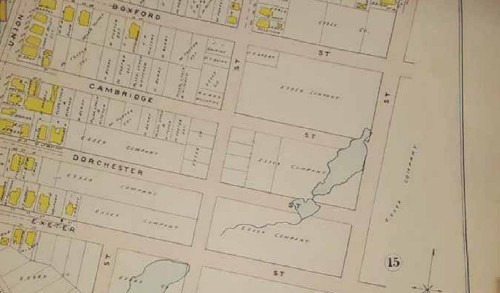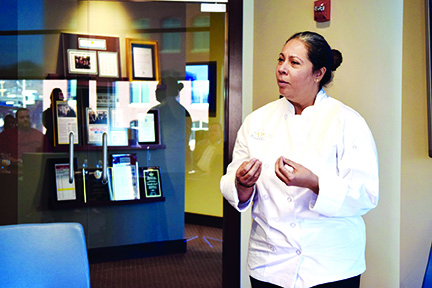
To begin with I noticed that Eddings’ article states that the Kane School opened in 1963. That statement is inaccurate. It opened in 1961. I was still only 9 years old that year when I entered the 5th grade at the Breen next door. I would have been entering the 7th grade but as the Principal informed my mother that in effect double and triple promotions for little geniuses had stopped due to socialization problems with children on a different grade level.
I remember that when the Kane School was constructed it was situated on the slope coming down from Crawford Street and not down in the water worn ravine. The Kane’s gymnasium was constructed across the ravine on the slightly raised elevation at Grainger Street up against the back of properties located on Phillips Street. This kept the Kane buildings out of the wetland areas.
When the new South Lawrence East School (SLE School) was constructed it was placed right across the ravine on the east side of Osgood Street in the wetland. A massive culvert large enough in diameter to stand up inside was installed underneath the new school. In my opinion the SLE School should have never been situated across that ravine.
The problem with the Kane Park site is an old one. Starting near the Joseph Torrisi Memorial Bridge is an old underground spring known as Cold Spring. The old Cold Spring Brewery was at one time located nearby.
The water from Cold Spring still naturally runs under South Union Street and through Plaza 114. It has been culverted under the Plaza and it runs through a culvert located in between O’Reilly auto parts and Silva’s Package Store. It then runs through the lot line of some homes located on Exeter Street, where a pond used to be that was filled in in order to build more housing.
The intersection of Exeter and Phillips Street chronically floods due to the poor design of drainage in that area and the allowing of more culverting of the Cold Spring Brook back in the 1920s to be installed so that a home could be built on the northeast corner of that intersection.
The old culverting continues. The culverting may even be connected in with the street drainage from that intersection. The plans showing where the street drainage ties in should be located for verification in the City Engineer’s Office. Many of the City’s engineering documents and plans were tossed after Andy Wall left, when Mr. Rosario took over and wanted to tidy up the office.
The culverting under Exeter and Phillips Streets continues to run under the location of the former ravine. The former ravine included two additional connected ponds that were situated right where Kane Park is now. The old culvert continues from under the Kane Park and connects into the new culvert located under the SLE School which then discharges into the Shawsheen River’s fenway.
What I suspect is happening is that the new culverting under the SLE School is aggressively draining and siphoning the water out from under the Kane Park while the old culvert under the Kane Park is clogging. The clogging would slow and dam up the flow from the Cold Spring Brook located under Kane Park. The combination of static and dynamic water flow under the Kane Park would cause the Kane Park to sink just like the old ravine that was located there did at one time.
In my opinion the City’s Engineer should have requested an investigative study of the conditions of the Cold Spring and drainage culvert underneath the Kane Park before engineering drawings were prepared for a soccer field on the site. Maybe the City Engineer did just that and I do not know about it.
The documents are a lot to read and may include information on the pre-existing culverting and drainage conditions. The plans appear in general to deal more with the surface drainage than they do with the drainage that is deep down under and in constant flow. I cannot give a full opinion on this matter without reading through all of the plans and documents.
I suspect that the City hurried hastily to get the soccer fields constructed without more thoroughly studying the underlying conditions. It would have been nice if the City had included flood mitigation for the intersection of Exeter and Phillips Street before building a soccer field over the former ravine. Now if we ever wanted to correct the Exeter Phillips drainage problem we would have to excavate the soccer field. Coordination of efforts has been poorly administered in Lawrence for a very long time especially when it comes to drainage.
Look at Andover Street and its intersection with Clifton Street. That does not have to flood like it does. How about North Boylston Street where the City has allowed the flow of water from on the street to run across and damage private property with severe erosion that destroyed an in ground swimming pool?
The Bloody Brook culvert from Methuen through Lawrence into the Spicket River runs under lot lines between private properties in Lawrence. Its size needed to be increased due to the construction of new homes upline in Methuen and the filling in of what was Searles Pond on Jackson Street. The results of not doing the increased culvert size has caused the Back Bay Neighborhood along Jackson Street to flood severely and chronically.
When I served on the Lawrence Redevelopment Authority I tried to bring forward the idea of constructing a flood control canal where the Manchester Railway Line was located. Federal monies were available due to Congress’s concerns over climate change. The Mayor was bullish on getting a rail trail that had been hastily planned by the Merrimack Valley Planning Commission and others during previous years so he asked members of the LRA to block my effort.
Meanwhile the Arlington Neighborhood and Broadway near Cross Street has chronically flooded periodically since at least the 1970s. We cannot build our tax base upward in those areas if we do not solve the drainage issues which include separating sewers from storm drains.
It is easy to file lawsuits and blame everything on someone else rather than to address the real problems deep down under before you carry out a project. That is how you become a hero!
The old copy of part of a map is from a 1906 Atlas of Lawrence. The east end of Cambridge Street was later moved northward in order to avoid the old pond. Grainger Street was added at a later time. Dorchester Street was never constructed through the site.



